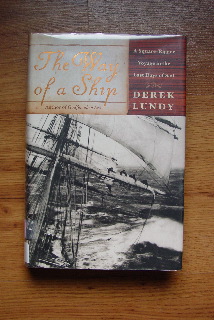|
The
Way of a Ship
A Square-Rigger Voyage in the Last Days of Sail
By Derek Lundy
Review by Steve
Fisher |
|
I was in the publishing business for twenty years,
and I was always suspicious of jacket blurbs, but this was the
first one I found completely misleading. This was to be an account
of the author’s ancestor aboard the Beara Head, a steel
hulled 4 masted barque. The author makes it perfectly clear
in his prologue that information about his ancestors sailing
days was sparse at best and that this would be a work of “fiction.”
Having said the above, I must say that this is a wonderful read
despite the fact that the blurb writer never even read the first
chapter.
Information about the author’s ancestor
was so sparse that he could not even identify the ship Benjamin
Lundy sailed on, and to that end the author created a ship that
would have sailed in 1885. The Beara Head, was a typical 4 masted
barque of the period carrying a bulk load of coal from England
to Chile. Coal, because it was a bulk commodity, enabled sail
to continue to compete with steam. Lundy graphically describes
life aboard one of these ships including all the hardships the
common seaman would experience from horrible food to undermanning.
But it was exactly these frugalities that enabled sail to last
into the early 20th century. What I found particularly interesting
was learning that coal was a very dangerous cargo because under
certain conditions it would spontaneously combust. Which happened
on this fictional voyage, necessitating digging by hand in the
holds while underway, to find the source of the fire.
Throughout the book, the author alternates chapters
on the trip with interesting chapters about the history of sail
and steam. Of particular interest to me were the frequent references
to the works of Melville, Dana and especially Joseph Conrad,
who was both a seaman and officer in this time period.
I truly enjoyed the read and would recommend it
to anyone with an interest in the period when steel hulled sail
ruled the seas. It made me want to read more of the works of
Joseph Conrad, something I’ll no doubt have time for with
the end of the building season upon us here in the Northeast.


